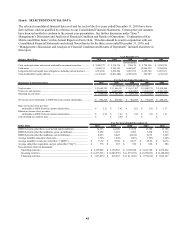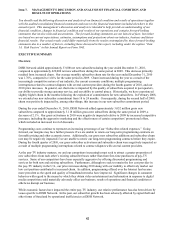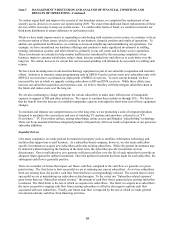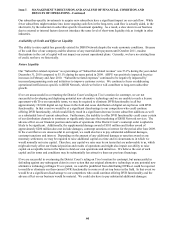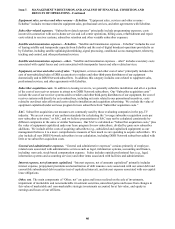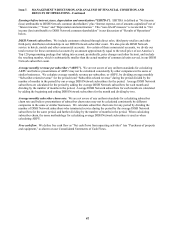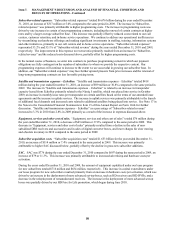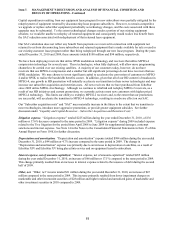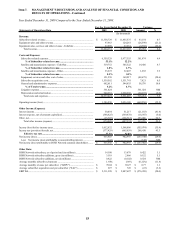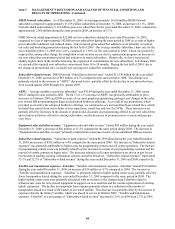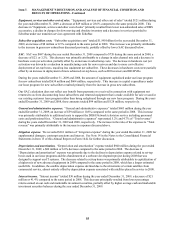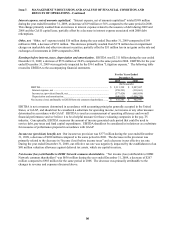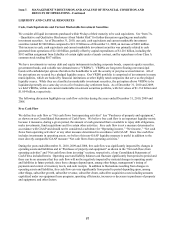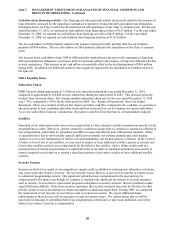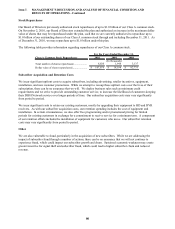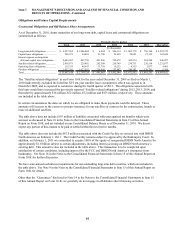Dish Network 2010 Annual Report Download - page 58
Download and view the complete annual report
Please find page 58 of the 2010 Dish Network annual report below. You can navigate through the pages in the report by either clicking on the pages listed below, or by using the keyword search tool below to find specific information within the annual report.Item 7. MANAGEMENT’S DISCUSSION AND ANALYSIS OF FINANCIAL CONDITION AND
RESULTS OF OPERATIONS - Continued
51
51
Capital expenditures resulting from our equipment lease program for new subscribers were partially mitigated by the
redeployment of equipment returned by disconnecting lease program subscribers. However, to remain competitive
we upgrade or replace subscriber equipment periodically as technology changes, and the costs associated with these
upgrades may be substantial. To the extent technological changes render a portion of our existing equipment
obsolete, we would be unable to redeploy all returned equipment and consequently would realize less benefit from
the SAC reduction associated with redeployment of that returned lease equipment.
Our SAC calculation does not reflect any benefit from payments we received in connection with equipment not
returned to us from disconnecting lease subscribers and returned equipment that is made available for sale or used in
our existing customer lease program rather than being redeployed through our new lease program. During the years
ended December 31, 2010 and 2009, these amounts totaled $108 million and $94 million, respectively.
We have been deploying receivers that utilize 8PSK modulation technology and receivers that utilize MPEG-4
compression technology for several years. These technologies, when fully deployed, will allow more programming
channels to be carried over our existing satellites. A majority of our customers today, however, do not have
receivers that use MPEG-4 compression and a smaller but still significant percentage do not have receivers that use
8PSK modulation. We may choose to invest significant capital to accelerate the conversion of customers to MPEG-
4 and/or 8PSK to realize the bandwidth benefits sooner. In addition, given that all of our HD content is broadcast in
MPEG-4, any growth in HD penetration will naturally accelerate our transition to these newer technologies and may
increase our subscriber acquisition and retention costs. All new receivers that we have purchased from EchoStar
since 2009 utilize MPEG-4 technology. Although we continue to refurbish and redeploy MPEG-2 receivers, as a
result of our HD initiatives and current promotions, we currently activate most new customers with higher priced
MPEG-4 technology. This limits our ability to redeploy MPEG-2 receivers and, to the extent that our promotions
are successful, will accelerate the transition to MPEG-4 technology, resulting in an adverse effect on our SAC.
Our “Subscriber acquisition costs” and “SAC” may materially increase in the future to the extent that we transition to
newer technologies, introduce more aggressive promotions, or provide greater equipment subsidies. See further
discussion under “Liquidity and Capital Resources – Subscriber Acquisition and Retention Costs.”
Litigation expense. “Litigation expense” totaled $225 million during the year ended December 31, 2010, a $136
million or 37.6% decrease compared to the same period in 2009. “Litigation expense” during 2009 included expense
related to the Tivo litigation for the period from April 2008 to June 2009 for supplemental damages, contempt
sanctions and interest expense. See Note 14 in the Notes to the Consolidated Financial Statements in Item 15 of this
Annual Report on Form 10-K for further discussion.
Depreciation and amortization. “Depreciation and amortization” expense totaled $984 million during the year ended
December 31, 2010, a $44 million or 4.7% increase compared to the same period in 2009. The change in
“Depreciation and amortization” expense was primarily due to an increase in depreciation on satellites, as a result of
EchoStar XIV and EchoStar XV being placed into service and on equipment leased to subscribers.
Interest expense, net of amounts capitalized. “Interest expense, net of amounts capitalized” totaled $455 million
during the year ended December 31, 2010, an increase of $66 million or 17.1% compared to the same period in 2009.
This change primarily resulted from an increase in interest expense related to the issuance of debt during the second
half of 2009.
Other, net. “Other, net” income totaled $31 million during the year ended December 31, 2010, an increase of $47
million compared to the same period in 2009. This increase primarily resulted from lower impairment charges on
marketable and other investment securities of $28 million and higher realized and unrealized gains of marketable and
other investment securities in 2010 compared to 2009.


